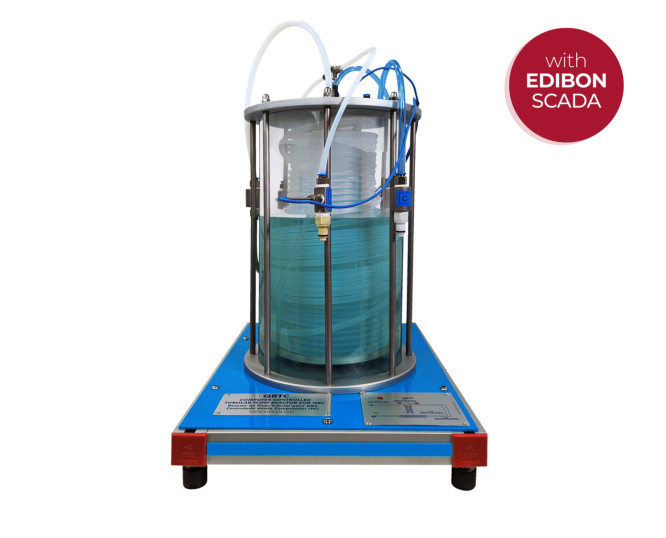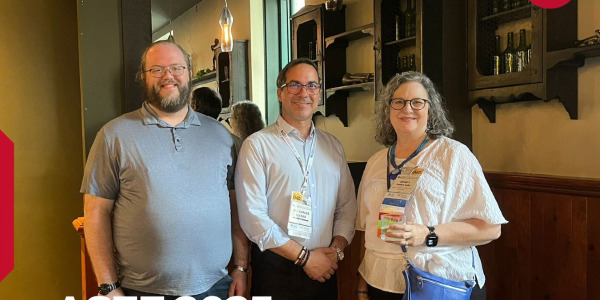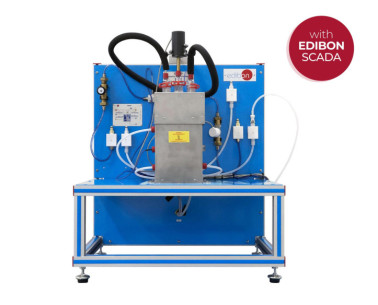QRTC Computer Controlled Tubular Flow Reactor for QRC
INNOVATIVE SYSTEMS
The Computer Controlled Tubular Flow Reactor for QRC, "QRTC", has been designed by EDIBON to conduct the kinetic study of homogeneous liquid-liquid reactions. In this unit, a continuous stream of reactants is passed through, which mix and react as they flow through the unit.
Expansions
Laboratories
RELATED NEWS
General Description
The Computer Controlled Tubular Flow Reactor for QRC, "QRTC", has been designed by EDIBON to conduct the kinetic study of homogeneous liquid-liquid reactions. In this unit, a continuous stream of reactants is passed through, which mix and react as they flow through the unit.
This unit allows for a wide range of practices, including determining kinetic equations, calculating constants, and comparing theoretical and experimental values of reactor conversion. Additionally, it enables the study of residence time effects and mixing effects on chemical reactions.
To work with this reactor, the Base and Service Unit, "QUSC", is required, which supplies the necessary reagents and thermostatic water for proper operation.
These Computer Controlled Units are supplied with EDIBON Computer Control System (SCADA), and includes: The unit itself + a Control Interface Box + a Data Acquisition Board + Computer Control, Data Acquisition and Data Management Software Packages, for controlling the process and all parameters involved in the process.
Exercises and guided practices
GUIDED PRACTICAL EXERCISES INCLUDED IN THE MANUAL
- Determination of the ionic conductivities.
- Theoretical conversion of the tubular reactor.
- Experimental determination of the tubular reactor conversion.
- Dependence on the residence time.
- Determination of the reaction order.
- Dependence of the rate constant and the conversion on the temperature.
- Sensors calibration.
MORE PRACTICAL EXERCISES TO BE DONE WITH THE UNIT
- Analysis of reagents and products.
- Conductivity measurement system: conductimeter.
- Complete emptying of the unit.
- Determination of the reaction rate constant.
Other possibilities to be done with this unit:
- Many students view results simultaneously. To view all results in real time in the classroom by means of a projector or an electronic whiteboard.
- Open Control, Multicontrol and Real Time Control. This unit allows intrinsically and/or extrinsically to change the span, gains, proportional, integral, derivate parameters, etc, in real time.
- The Computer Control System with SCADA and PID Control allow a real industrial simulation.
- This unit is totally safe as uses mechanical, electrical and electronic, and software safety devices.
- This unit can be used for doing applied research.
- This unit can be used for giving training courses to Industries even to other Technical Education Institutions.
- Control of the unit process through the control interface box without the computer.
- Visualization of all the sensors values used in the unit process.
- By using PLC-PI additional 19 more exercises can be done.
- Several other exercises can be done and designed by the user.
SUPPLEMENTARY EQUIPMENT
Base and Service Unit for QRQC
Isothermal Reactor with Stirrer
Isothermal Reactor with Stirrer and Distillation
Tubular Flow Reactor
Reactors with Stirrer in Series
Adiabatic and Isothermal Reactor
Computer Controlled Chemical Reactors
Base and Service Unit for QRC
Computer Controlled Continuous Stirred Tank Reactor for QRC
Computer Controlled Batch Reactor for QRC
Computer Controlled Stirred Tank Reactors in Series for QRC
Quality

AFTER-SALES SERVICE

 Cookie preferences
Cookie preferences




























